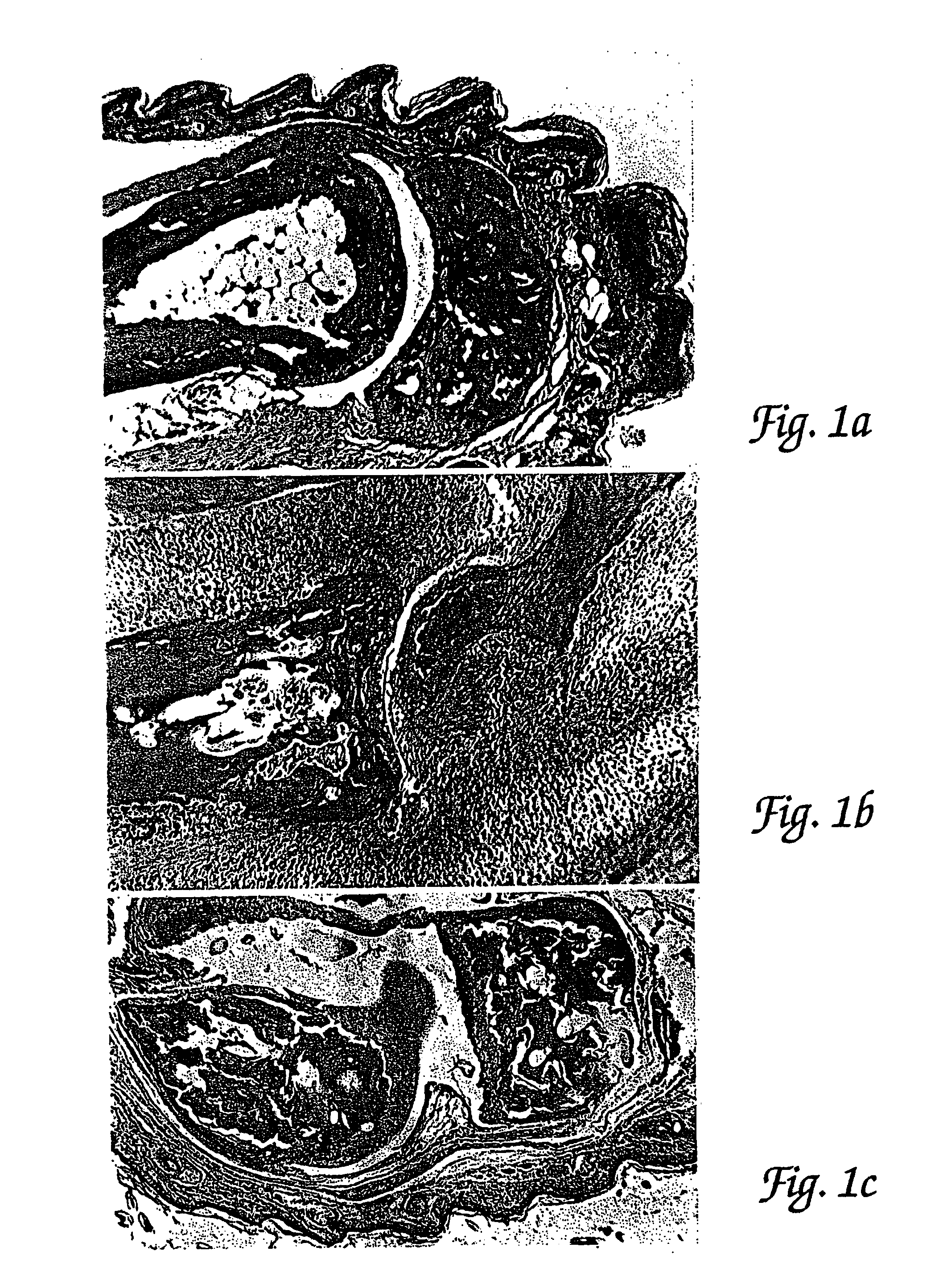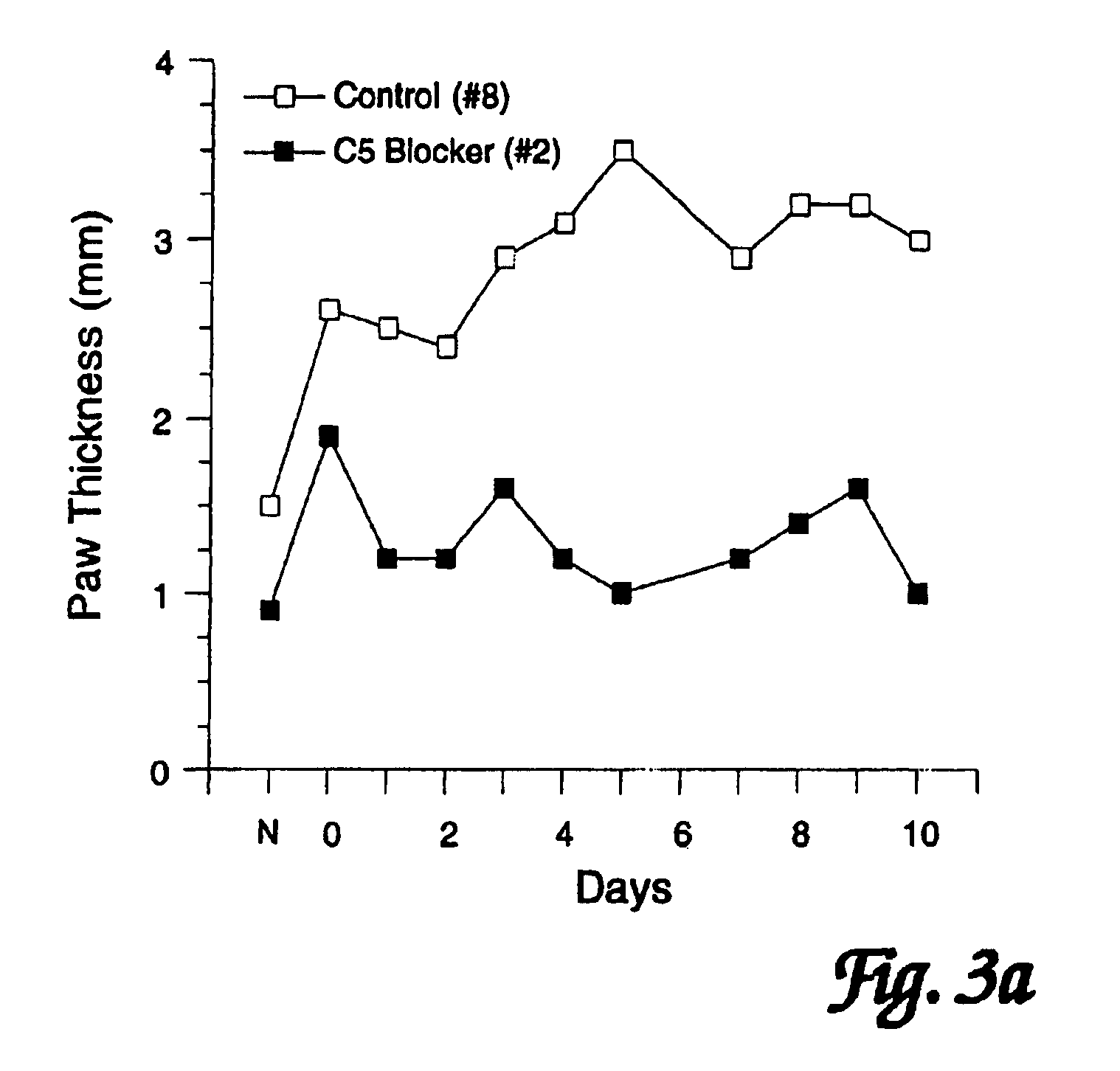Methods for the treatment of inflammatory joint disease
a technology for inflammatory joints and treatment methods, applied in the direction of immunological disorders, drug compositions, peptides, etc., can solve the problems of affecting the health of patients suffering from such disorders, the treatment of patients is not as safe and effective as could be desired, and the disability of affected individuals is often high, so as to prevent the progression of joint inflammation
- Summary
- Abstract
- Description
- Claims
- Application Information
AI Technical Summary
Benefits of technology
Problems solved by technology
Method used
Image
Examples
example 1
Therapeutic Effects of C5 Blocker Treatment after the Clinical Onset of Collagen Induced Joint Inflammation
[0098]In order to assess the effects of administration of a C5 blocker on established JI, mice were observed following induction of CIJI, as described above, and pairs of mice were selected that showed the initial appearance of readily detectable JI symptoms (swollen joints of the paws) on the same day. One mouse of each such pair was treated with a anti-C5 mAb BB5.1 and one was treated with a control injection of either the irrelevant mAb 135.8 or PBS. In each matched pair, the animal with the greatest overall level of paw inflammation was assigned to the C5 blocker treatment group so as to avoid potentially biasing the results in favor of the C5 blocker treatment. Starting on the first day when joint inflammation was observed as paw inflammation, treatments were continued daily for 10 days. (In one case a pair of mice was only carried for 8 days.) In addition to these matched...
example 2
Prophylactic Treatment with a C5 Blocker Prevents Collagen Induced Joint Inflammation
[0104]In these experiments, the administration of the C5 blocker coincided with the reimmunization of the experimental animals with B-CII. On the day of reimmunization, mice were symptom free, and were randomly assigned to C5 blocker treatment or control treatment groups. Each mouse was treated with either the C5 blocker (anti-mouse C5 mAb, BB5.1) or a control treatment (anti-human C8 mAb, 135.8) at 750 μg per mouse ip twice weekly. The animals were treated for four weeks, at which time treatment was discontinued. The results of this study are shown in FIGS. 4 and 5.
[0105]Administration the C5 blocker completely prevented the development of CIJI (0 / 8). All mice in the C5 blocker treated group exhibited no signs of clinical disease during the period of treatment (and for up to two months after discontinuing the C5 blocker therapy in the two animals followed for that long). In contrast, 90% of the con...
example 3
Effect of C5 Blocker Treatment on the Humoral and Cellular Immune Responses to Immunization with Collagen
[0107]Responses of both the humoral and cellular immune systems are activated after immunization of DBA / 1LacJ mice with bovine Collagen II. Anti B-CII titers increase, and the serum IgG anti B-CII titers in C5 blocker treated mice are equivalent to those of control treated mice when tested at 14, 28 and 42 days after the initial B-CII immunization (FIG. 6a). Anti B-CII antibody titers from both control and anti-C5 mAb treated mice rise significantly after the B-CII reimmunization and remain at the resulting plateau for an extended period of time.
[0108]In order to study T cell responses, lymph node cells (LNCs) from C5 blocker treated mice and control treated mice were cultured with either B-CII, B-CI, C-CII, or culture medium only. LNCs from either C5 blocker treated mice or control treated mice responded specifically and equally to B-CII regardless of the treatment the animals r...
PUM
| Property | Measurement | Unit |
|---|---|---|
| concentrations | aaaaa | aaaaa |
| volume | aaaaa | aaaaa |
| volume | aaaaa | aaaaa |
Abstract
Description
Claims
Application Information
 Login to View More
Login to View More - R&D
- Intellectual Property
- Life Sciences
- Materials
- Tech Scout
- Unparalleled Data Quality
- Higher Quality Content
- 60% Fewer Hallucinations
Browse by: Latest US Patents, China's latest patents, Technical Efficacy Thesaurus, Application Domain, Technology Topic, Popular Technical Reports.
© 2025 PatSnap. All rights reserved.Legal|Privacy policy|Modern Slavery Act Transparency Statement|Sitemap|About US| Contact US: help@patsnap.com



